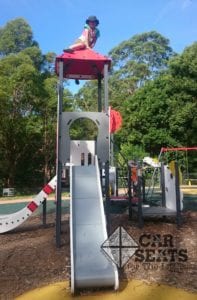As Child Passenger Safety Technicians, we spend a lot of time helping caregivers with their very first car seats. From offering advice around choosing that first rear facing only or convertible car seat to assistance around installation and use, we spend more time with parents of the 0-2 set than any other age group. They roll into our car seat and booster seat check events and listen carefully while we help get their vehicle ready for the ride.
While we love helping those caregivers, our heart breaks when we stop hearing from those same parents after their child reaches a certain age.
I once worked an educational event at a local store. Many, many expectant parents and parents of babies wandered up to my table or took a trip up and down the car seat aisle while we explored the differences between the various car seats. Very few parents of children who can walk and talk took the time to chat.
It’s these parents who we’d like to reach during this Child Passenger Safety Week. And well, every week.
Darn Kids
Kids can be fearless. They can scramble to the top of everything in the playground, whether it was made for climbing or not. They can charge into the ocean when they’re released into the lifeguarded zone. They can jump off of swings, climb trees, balance on walls. My kids absolutely embrace all of these inherently risky behaviors.
Though they are charming and funny, having this particular model of Little is not good for the blood pressure. But I know that those moments when they’re conquering the playground is not when they’re in the most danger; the ride to the playground is. That’s why here at CSFTL we advocate for every kid to be in the proper car seat for every ride: vehicle crashes are still the leading cause of death for children.
What might surprise you is which of the kids in my family is the most likely to have a peer in danger in the car. My extended family includes kids who are pretty evenly spaced between 6 months and 9 years old.
Who is Riding in a Booster?
After looking at the data on booster seat usage and injury, the babies are not the kids I worry about. The kids I’m worried about are not the ones crawling, or the ones gleefully sliding down the slides. It’s the ones at the very top of the playground: our oldest kids are the children least likely to be properly restrained in the car.
Some state laws require a child to ride in a car seat or booster seat until they’re 8 years old. Unfortunately, many caregivers interpret this to mean that the moment a child turns 8, parents can toss the booster seat and move the child to the front vehicle seat in one fell swoop.
This is nowhere close to best practice. In fact, it’s a very risky practice.
Best practice is for a child to ride in a booster seat until they’re 4 foot, 9 inches tall and can pass the Five Step Test.
Best practice is for children to ride in the back seat until they’re at least 13 years old.
In the summer of 2015 a group of researchers in the United States looked in cars at many locations and recorded what kind of car seats and booster seats kids were riding in. The results were particularly troubling for children between the ages of 4 and 7: a quarter of them were not riding in any car seat or booster seat at all.
When we include older children, the snapshot is perhaps more troubling still: nearly one half of children under 53 inches tall were in a seat belt or nothing at all. This represents an increase from when similar data was sampled in 2013. Every single one of these children needs a booster seat to have a fighting chance to survive a crash.
NHTSA suggests that children won’t fit properly in the vehicle seat belt until they are at least 57 inches tall. We advocate that children ride in a car seat or booster seat until they can consistently pass the Five Step Test — usually that’s when the child is at least 57 inches tall. If the vehicle seat belt doesn’t yet fit properly on a tween’s hips and collarbone, the risk of severe abdominal and spinal injuries is vastly elevated.
Among children who are under 53 inches tall, half of them are riding in the vehicle seat belt alone.
Every one of these children needs a booster seat.
Abdominal injury data shows a spike in crash-related abdominal injuries at the age of 7. This finding correlates with the ending of child passenger safety laws in many states: in much of the United States it becomes legal for children to ride in the vehicle seat belt alone on their 7th birthdays. But no 7 or 8 year old is safe in the vehicle seat belt alone. An astonishingly small number of 8, 9, 10, and 11 year olds fit the vehicle seat belt well without a little boost from a booster seat. Every one of these children needs a booster seat.
Booster seats are not expensive. They are not cumbersome. They are easy to use and easy to obtain. So why are we putting our oldest children at the risk of severe injury or death at a rate of 50%? That’s hard to answer. Surely most parents don’t know that vehicular safety for the 7-11 year old age group requires as much attention as that of our babies and toddlers.
Many parents, even those who recognize that laws around child passenger safety don’t align with best practice for the youngest of passengers may assume that the law offers adequate protection for this 7-11 year old demographic. Some parents may be succumbing to the peer pressure of parents who also did not understand the gravity of the decision to let a 7 year old ride without a booster seat.
Whatever the reasons, something needs to change. We need to protect our biggest kids just as we protect our babies. So what can we do with this troubling news that our most vulnerable passengers are the oldest of our kids?
- Keep them in booster seats. This is an inexpensive, effective way of protecting our children in cars until the vehicle seat belt fits them properly
- Advocate booster use in our elementary, primary, and middle schools. School administrators work hard to keep our kids safe during the school day and sometimes need a parent task force to help keep them safe on the ride home. If we could get the information out there that every child hopping in a car in the carpool line at every elementary school gets in the back with a harnessed car seat or a booster seat, maybe we could make a dent in the number of children who are injured each year in vehicle crashes.
My kids scare me with their behavior at times, I’m not embarrassed to admit. But I also fiercely admire their fearless spirits and wish I could be a bit more like them. I try: I do climb to the top of the playground when I’ve had enough coffee, and the view from up there is divine. But when we get in the car to go home, I promise to keep every one of them, from the babies to the tweens, safely buckled with the correct car seat, in the back seat, with no exceptions.
Join us this week as we focus our attention on these underserved older kids and share a number of ways to help them have a safe ride on every trip!








